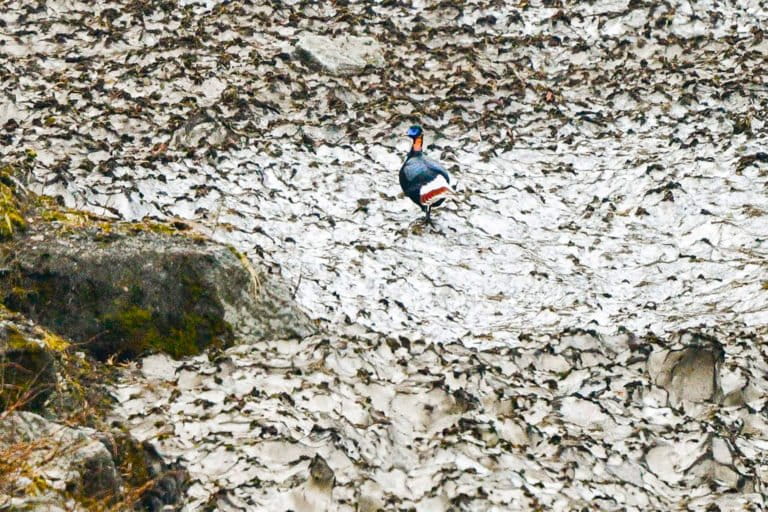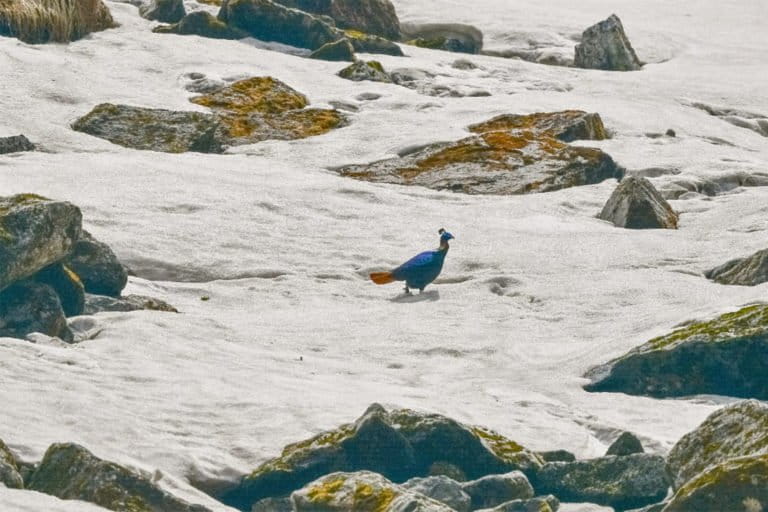- Concerns on unregulated tourism have undercut the excitement of visually documenting the presence of two species of Himalayan pheasants in the high mountains of Arunachal Pradesh.
- Himalayan pheasants noted for their attractive plumage, face a high degree of threat from hunting and habitat loss throughout their range in the Himalayas, note researchers calling for stringent implementation of wildlife protection laws.
- They are recognised for their role as biological indicators of forest quality and human-caused disturbances but very little is known about their ecology. Emerging concerns on climate change-related impacts on their distribution have also been flagged by researchers.
The first clear photographic record of two pheasant species in Arunachal Pradesh’s Upper Siang district has brought in a mixed bag of emotions among birding enthusiasts and researchers. The Himalayan pheasants face habitat loss and hunting-associated threats and the sightings signal safe habitats. But unregulated tourism and future climatic changes may take the sheen off these striking birds.
The birds, a male Sclater’s monal (Lophophorus sclateri) and a pair of Himalayan monals (Lophophorus impejanus) were among 88 bird species sighted by wildlife enthusiasts Obang Mibang, Tajir Tamuk and Geyong Tayeng during an expedition to the snow-clad Mount Eko Dumbing at 4,173 metres above mean sea level in the Upper Siang district touching the international border with China. The expedition was led by mountaineer Kishon Tekseng who had scaled Mt. Everest in 2018.
“We knew there was Sclater’s monal in the area but we also saw Himalayan monals which we were not expecting to spot. Over three days, we sighted 88 bird species in the snow-enveloped region — if we could have scientists come and undertake formal surveys and scientific assessments then we would have a better understanding of the region’s biodiversity,” Obang Mibang told Mongabay-India.

While the Himalayan monal is marked as a species of least concern by the IUCN Red List of Threatened species, the Sclater’s monal is listed as vulnerable. The Himalayan pheasants are grouped under Phasianidae of the order Galliformes; besides pheasants, other birds like partridges, francolin, quails and snowcocks also constitute the Galliformes. Of the 51 species of 16 genera of pheasants found in Asia, as many as 17 pheasant species are reported from India, of which 16 species occur in the Himalayas. The pheasants are listed under Schedule I and Schedule IV of the Wildlife (Protection) Act, 1972.
Mibang, who is in the government service, expressed apprehension about unregulated tourism in these remote areas which may affect the birds’ habitats. Daniel Mize, an assistant professor of zoology at the Rajiv Gandhi University, Arunachal Pradesh, who helped identify the pheasants, echoed Mibang. Mize fears a repeat of the black-necked crane scenario where tourists have made a beeline for Sangti and Zemithang Valleys in the state to sight and photograph the birds in an unregulated manner.
Sightings of the black-necked crane, once regularly spotted in Sangti and Zemithang Valleys during its non-breeding time, have drastically reduced; the reduction is attributed to rising human settlements, power grid construction wires, and hydroelectric projects that cross the bird’s wintering sites.
“In India, Sclater’s monal is recorded only from Arunachal as far as we know; you won’t find it below 1500 metres. Maybe there are other habitats in Arunachal that are also suitable and you may see them there occasionally and for fleeting moments but, so far, we know this habitat (Mount Eko Dumbing) is probably the most suitable one for now. So we need to be cautious of excess tourism and human disturbances in those areas,” Mize told Mongabay-India, reminiscing the rare sightings of the Sclater’s monal at Mayodia Pass, his hometown, at an altitude of 2,655 metres above sea level.
Because monals are ground-dwelling, nest on the ground and have short flight ranges, they have a hard time with any disturbance on the ground, explained Mize. He added that they are hunted and trapped for meat for local consumption and for extracting feathers.

Understanding knowledge gaps on pheasants
Ghazala Shahabuddin, a Senior Fellow at the Centre for Ecology, Development and Research (CEDAR), Delhi, says Himalayan pheasants, in general, are likely to be more threatened than other smaller birds because of their large home range requirements.
“While we know very little about them, they do face a high degree of threat from hunting throughout their range in the Himalayas,” Shahabuddin told Mongabay-India. Habitat change in high altitude meadows such as ingrowth of trees and spread of invasive species is also imperilling their populations. Eleven pheasant species are on the IUCN Red List of Threatened Species.
“For example, the koklass pheasants need hardwood forests which are disappearing in the Western Himalayas; while they do feed in open habitats they need thick forests as hideouts. The chir/cheer pheasants that need open pine savannas are also rarely spotted nowadays, restricted to certain sites,” Shahabuddin said.
Even the high-altitude Himalayan monal, believed to be more common, isn’t doing so well in the western Himalayas. “Himalayan monals aggregate in some areas likely due to behavioural habituation with people. For this reason, people think they are doing well. But they need a complex mosaic of habitats including meadows and rocky ridge-tops for survival, which are increasingly used by tourists.”
“We know very little about monal pheasants due to lack of field studies or observations that could back up speculations on their conservation status. In comparison, we know much more about the lower altitude pheasants, such as the kalij pheasants (Lophura leucomelanos),” adds Shahabuddin.

According to Merwyn Fernandes, in addition to habitat alterations (loss) and poaching including extraction of eggs “in some parts of the Himalayas, fires during the breeding season (March-May) also affect them,” Fernandes, associated with TRAFFIC, told Mongabay-India. Fernandes stressed on the strict implementation of the Wildlife (Protection) Act, 1972 for their protection. “Awareness among law enforcement agencies including the judiciary about the pheasants and community-based conservation measures with strict adherence to provisions of WPA 1972 are important steps needed to conserve them,” Fernandes added.
Extending conservation across landscapes
Land-use change, habitat degradation, climate change, pollution and invasive alien species continue to threaten biodiversity in the Hindu Kush Himalayas notes the Hindu Kush Himalaya Assessment, emphasising that imperilled biodiversity affects the ability of natural ecosystems to support human needs. These drivers collectively act and make habitats and ecosystems vulnerable, change species composition and induce species loss. A key concern is the loss of endemic species — plants and animals that have evolved in particular elevation and climatic gradients and niches in the HKH.
Recently, modelling studies on Himalayan pheasants have discussed the likelihoods of shifting of the range of the Himalayan pheasants under future climatic scenarios.
According to Bijoy Chhetri, co-author of a paper that targeted three pheasant species across varying altitudes in the eastern Himalayas — Himalayan monal in the higher elevations, blood pheasant (Ithaginis cruentus) in the mid-ranges, and kalij pheasant in the lower altitudes — the birds are likely to move to higher elevations and out of protected areas in response to climate change into more suitable areas that will require effective management.
Corresponding author Hemant Badola, formerly with G.B. Pant National Institute of Himalayan Environment and Sustainable Development, Sikkim Unit, said the species-specific response of climate change remains poorly documented in the Himalayas. “And it is essential to develop and scale-up conservation plans with a focus on transboundary regions and multilateral cooperation between governments of the region,” said Badola, former advisor to the Chief Minister, Sikkim on biodiversity and climate change.
Another study spanning western and eastern Himalayas focused on 21 Galliformes species, 20 of which were range-restricted within the Himalayas. It included the high-altitude Sclater’s monal, clustered in the study as Eastern Himalayas, Dense Vegetation-affinity Galliformes (EHGVG), along with blood pheasant, Blyth’s tragopan, chestnut-breasted partridge, satyr tragopan, Temnick’s tragopan, and Tibetan partridge.
Spinning to 2070, the study spanning two emissions scenario (Representative Concentration Pathways or RCP 4.5 and 8.5) shows that “all Galliformes, in the eastern Himalayas, are expected to suffer a loss in their habitat by 2070, in both RCP scenarios,” said study author Lalit Sharma, of the Zoological Survey of India. As for the cluster belonging to the western Himalayas, which included Himalayan monal and koklass, it was predicted to lose about 70 percent of its bioclimatic habitats in both scenarios.

Nakul Chettri, Regional Programme Manager, Transboundary Landscapes at International Centre for Integrated Mountain Development adds that there are indications of vegetation shift to a higher elevation, change in phenology and species reported in new elevation — both plants and animals.
For example, a study on the Chinese monal (Lophophorus lhuysii) revealed that its current distribution range is quite limited and it will likely shift toward both higher elevation and higher latitude under future climate change. Suggestions include an expansion and adjustment of the nature reserve network to fill current and future gaps in protection, the establishment of corridors to facilitate population dispersal and colonisation. Another research on satyr tragopan (Tragopan satyra) used global positioning system/accelerometer telemetry to track the partial altitudinal migration of the bird in central Bhutan called for extending conservation measures across “multiple mountains, protect the full range of forest types and encompass multiple landscape configurations.”
“In general, our protected area analysis says that high altitude area and lowland area are less represented in protected area coverage in the Hindu Kush Himalaya. Hence, better representation or even corridors between the protected areas may help,” Chhetri told Mongabay-India.
Banner image: A Himalayan monal. Photo by Tom Tarrant/Flickr.
